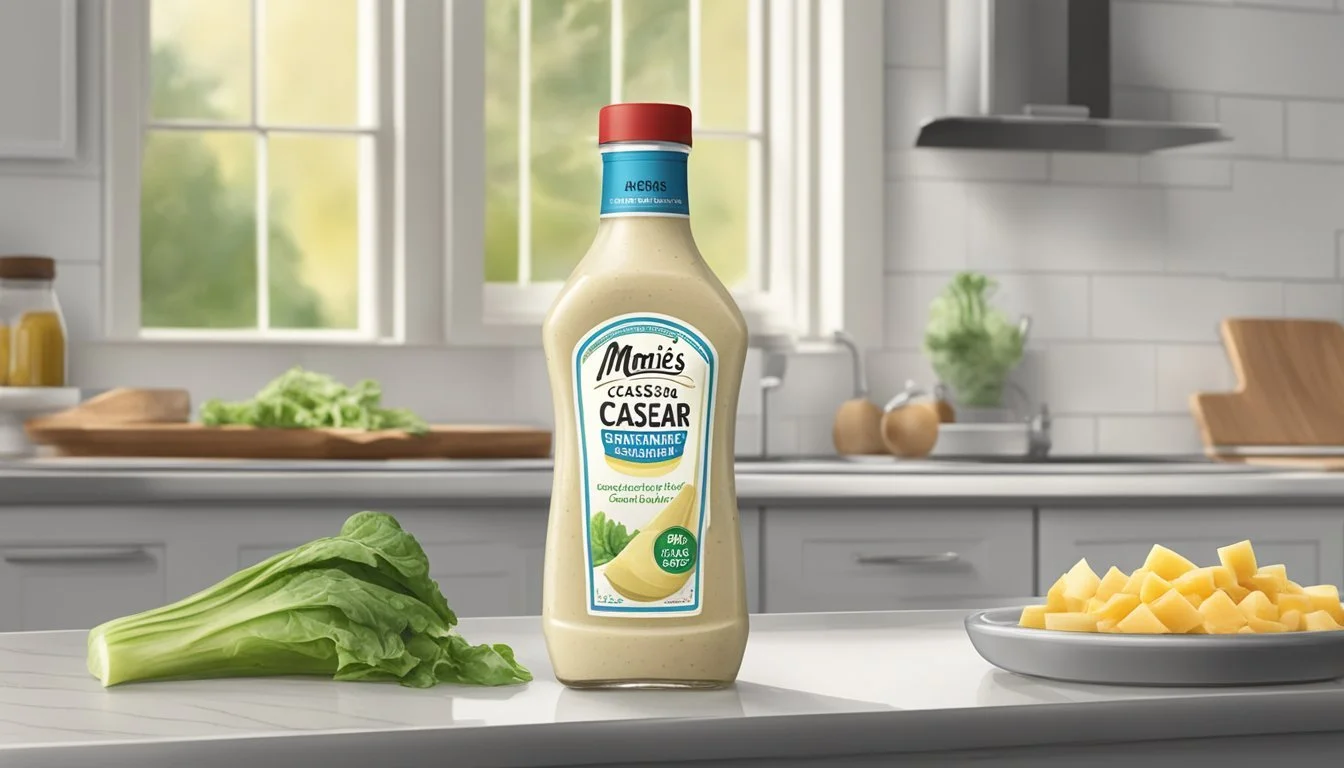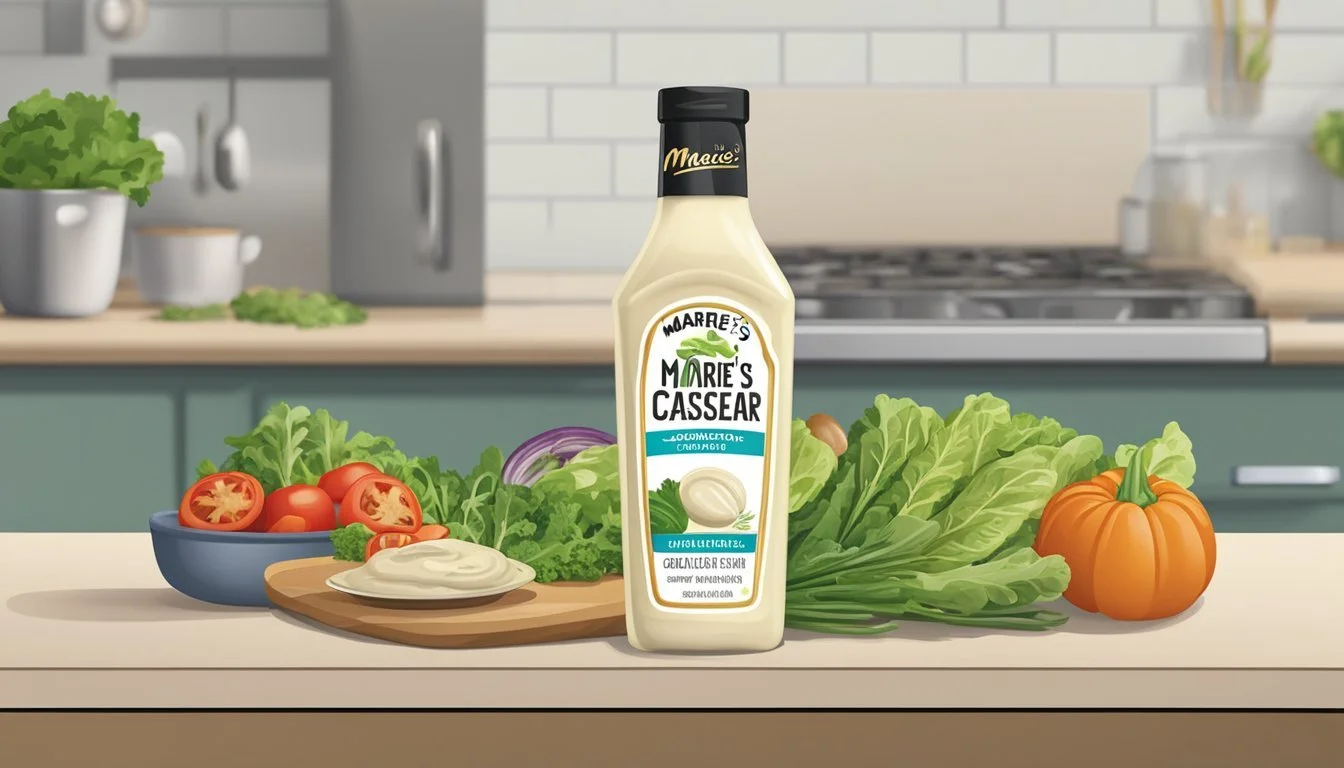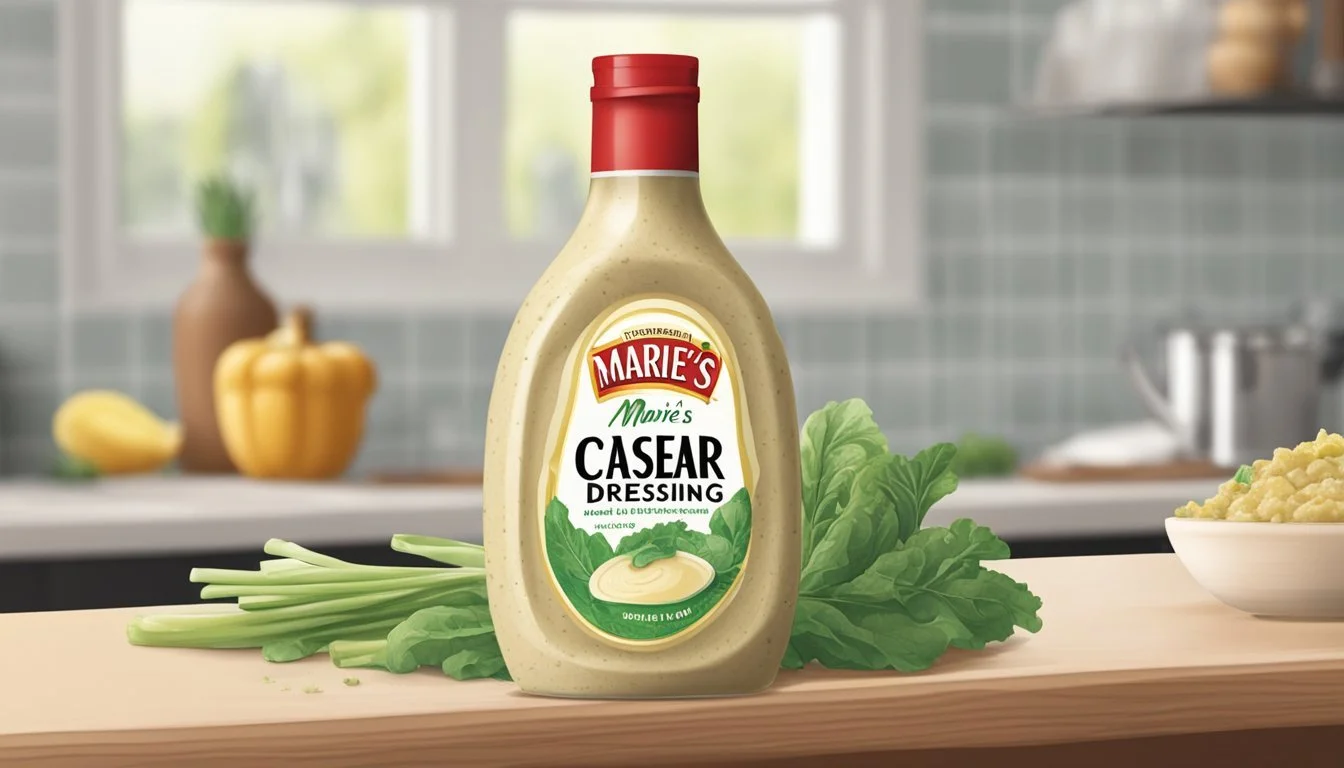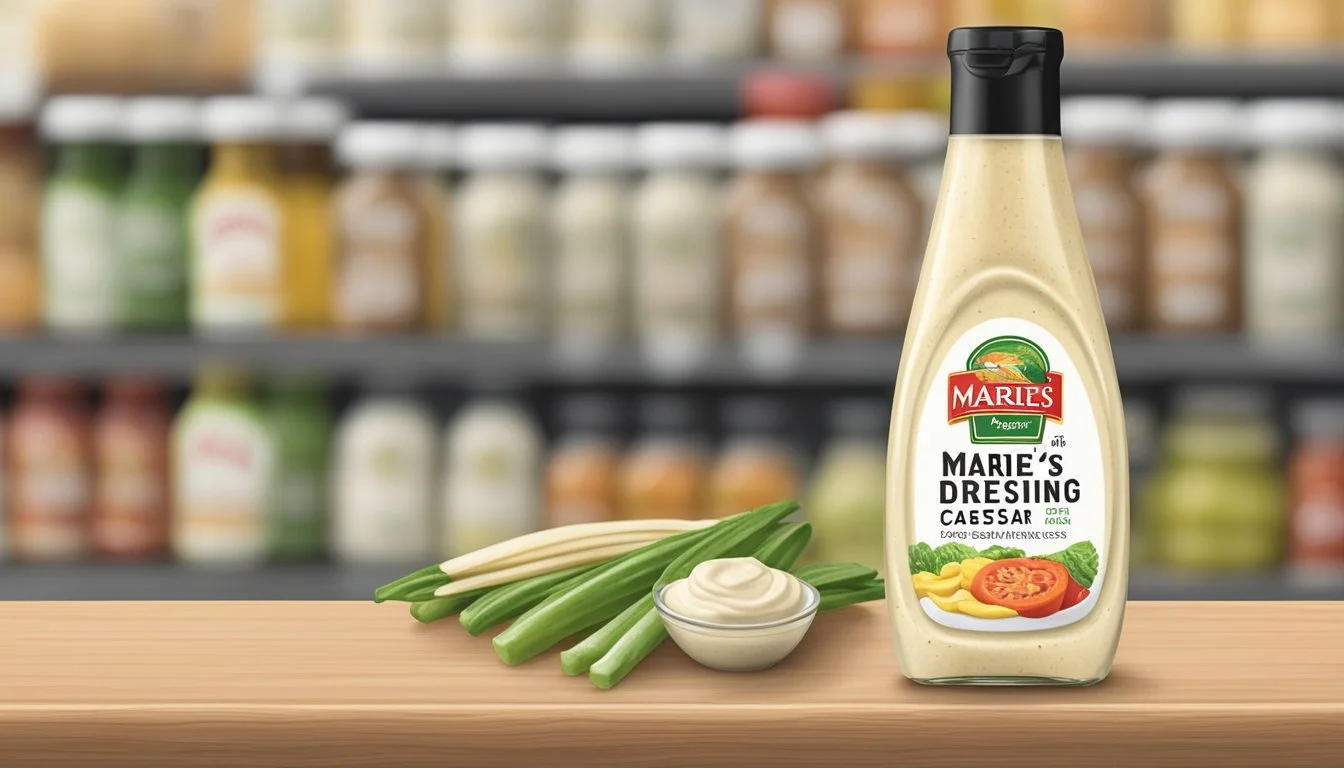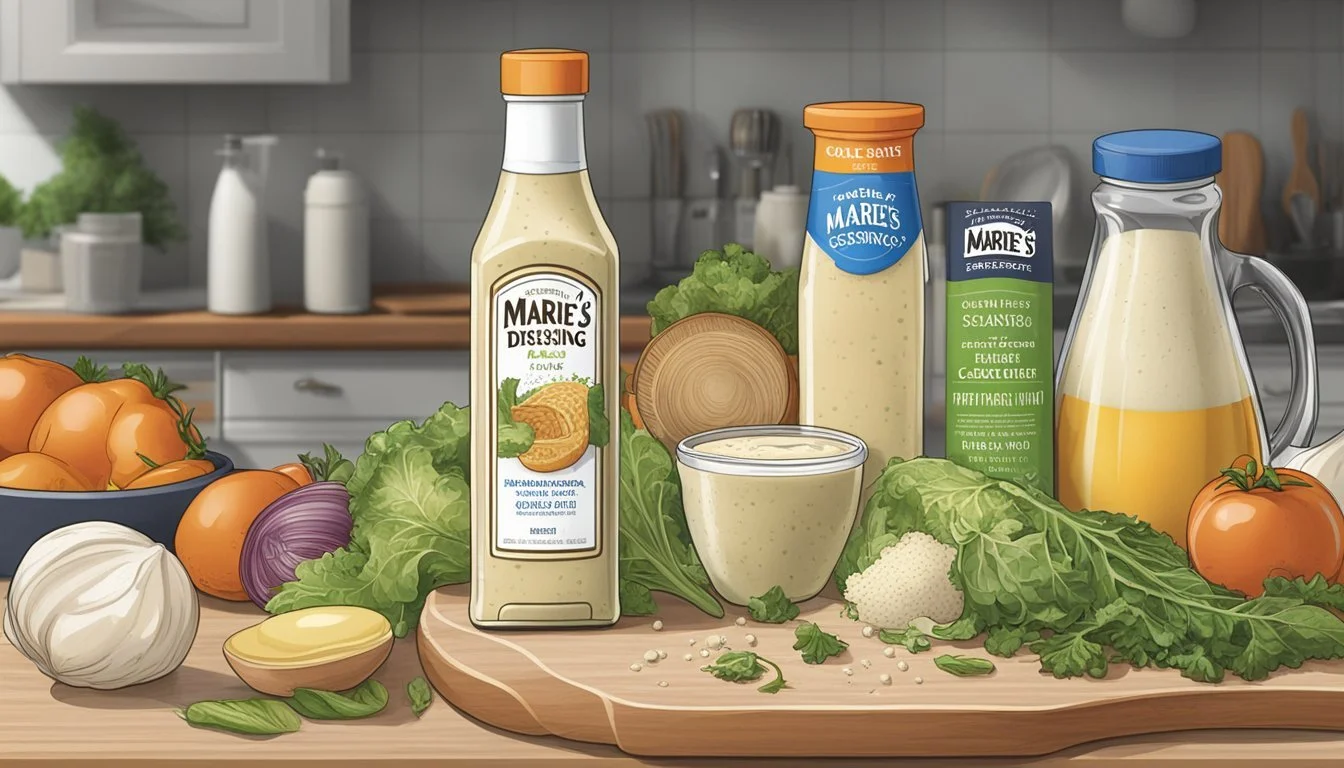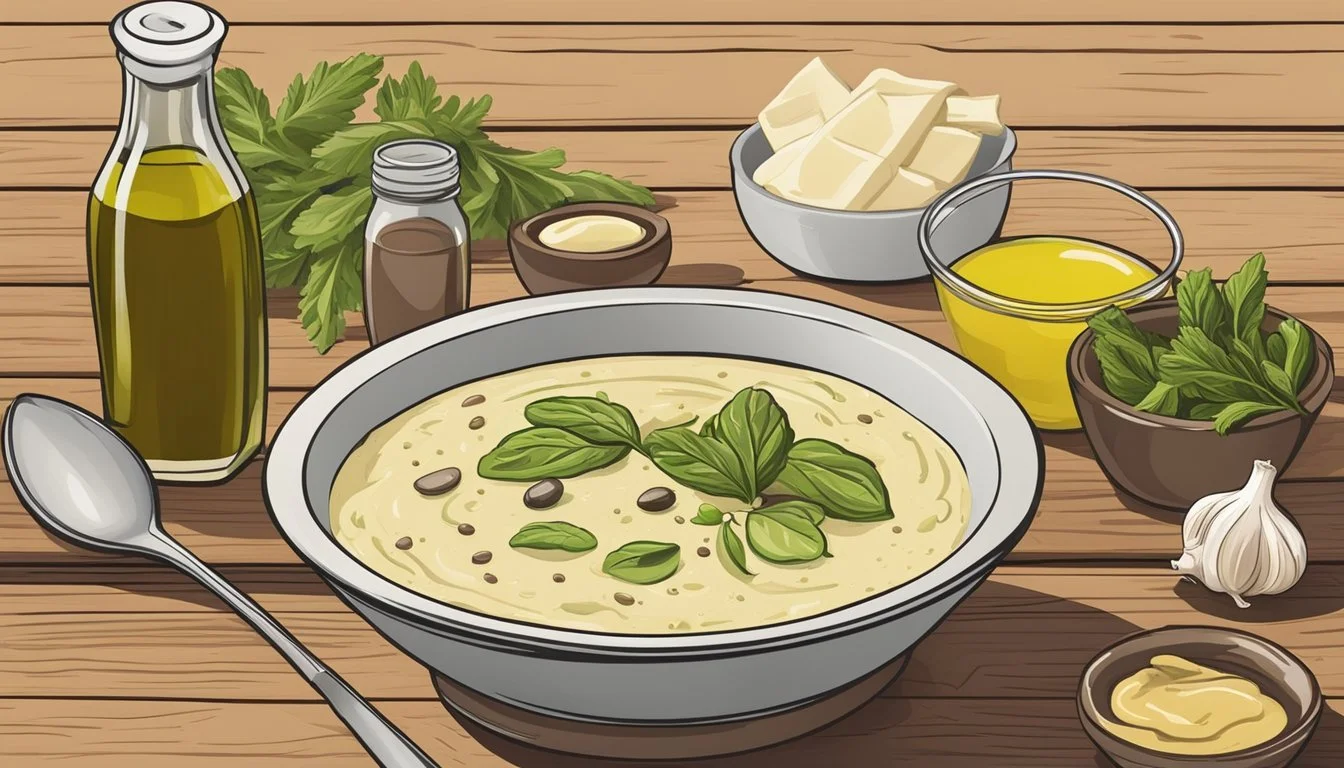How Long Does Marie's Caesar Dressing Last?
Shelf Life and Storage Tips
Marie's Caesar dressing is a popular condiment that adds a rich, tangy flavor to Caesar salad and a variety of other dishes. Its longevity once opened can depend on various factors including the presence of preservatives, the storage conditions, and the quality of the ingredients. When stored continuously in the refrigerator, an opened bottle of Caesar salad dressing, like Marie's, generally stays at its best quality for about 6 to 9 months.
It's important to note that while Marie's Caesar dressing can maintain its flavor and safety for quite some time under proper refrigeration, the quality may begin to wane. Consumers can typically rely on the dressing to enhance their meals with its distinct Caesar salad taste well beyond its printed expiration date, as long as there are no signs of spoilage such as an off smell, unusual color, or separation that stirring does not fix.
As a dairy-based dressing with a mayonnaise foundation, Marie's Caesar variety is particularly sensitive to temperature changes. For this reason, keeping it refrigerated once opened is crucial. Before reaching for the bottle to dress a salad, consumers should always conduct a quick quality check to ensure the best dining experience.
Understanding Caesar Salad Dressing
In the world of condiments, Caesar salad dressing stands out for its robust flavor profile and creamy texture, created from a unique blend of ingredients. This section delves into the makeup and variations of this popular dressing, providing an understanding of its culinary significance.
Key Ingredients
The foundation of Caesar dressing is a combination of several key ingredients that contribute to its distinct taste and texture. Here is a list of the main components that are typically used in preparing this dressing:
Anchovies: (What wine goes well with anchovies?) Offer a punch of umami and a slightly fishy note, which is signature to Caesar dressing.
Dijon Mustard: Contributes a tangy depth and helps to emulsify the dressing.
Worcestershire Sauce: Adds complexity with its savory, slightly tangy profile.
Olive Oil: Serves as the base oil, providing a smooth texture and a fruity undertone.
Garlic: Delivers a sharp, aromatic flavor essential to the dressing's overall taste.
Parmesan Cheese: Brings a salty, nutty element and adds to the creamy texture.
Lemon Juice: Imparts a fresh, citrusy zing and brightens the flavor profile.
Vinegar: Often red wine or white vinegar, contributing additional sharpness and tang.
Raw Egg: Traditionally used to emulsify and create a velvety consistency.
Taste Profile
Caesar dressing is known for its rich, creamy texture combined with a balance of tangy, savory, and salty flavors. The dressing's taste profile can be described as:
Savory: Mainly from anchovies, parmesan cheese, and Worcestershire sauce.
Creaminess: Offered by the blended oil and raw egg or emulsifiers in egg-free versions.
Tanginess: From mustard, lemon juice, and vinegar, which also serve as natural preservatives.
Garlicky: A distinct kick from fresh or powdered garlic.
Umami and Salty: Fully expressed through anchovies and parmesan cheese.
Popular Variations
Over time, several variations of Caesar dressing have emerged, catering to a range of palates and dietary requirements:
Classic Caesar: The traditional recipe including anchovies, parmesan, lemon juice, and raw egg.
Vegetarian: Excludes anchovies and might use a plant-based cheese substitute.
Vegan: Omits all animal-derived ingredients and utilizes substitutes like vegan Worcestershire sauce and nutritional yeast.
Dairy-Free: Replaces parmesan with alternative cheese types or omits it entirely.
Lighter Versions: May reduce oil content and use low-fat alternatives for a healthier option.
Understanding the key elements that constitute Caesar dressing, its flavor composition, and the various adaptations available provides cooks and consumers with a comprehensive picture of this versatile condiment's role in culinary arts.
Shelf Life of Caesar Dressing
The shelf life of Marie's Caesar Salad Dressing varies based on whether the bottle is opened or unopened and its marked expiration date. Proper storage is crucial for maintaining the dressing's quality and safety.
Expiration Date Parameters
Unopened: An unopened bottle of Marie's Caesar Salad Dressing generally maintains best quality until the "best by" or "best-before date," which indicates the manufacturer's estimate for peak quality. It can typically last:
Pantry: 12 months (from production date)
Opened: Once opened, the dressing should be refrigerated and can last for a different duration, reflecting a shortened shelf life due to exposure to air and potential contaminants:
Refrigerator: 6-9 months (from the date of opening)
It's important to note that these durations assume continuous refrigeration and adherence to proper storage methods.
Signs of Spoilage
To determine if Marie's Caesar Salad Dressing has gone bad, one should look for:
Offensive odors: A sour or unusual smell is a clear indicator.
Change in color or texture: Any significant changes from the original state, including the presence of mold, are signs of spoilage.
Taste alteration: If the flavor of the dressing has significantly deteriorated or tastes off, it should not be consumed.
Consumers are advised to discard any dressing that exhibits signs of spoilage, even if it's before the expected shelf life, to avoid foodborne illnesses.
Proper Storage Techniques
Maintaining the freshness and extending the shelf life of Marie's Caesar dressing is contingent upon adhering to specific storage techniques. The quality of the dressing can be greatly influenced by temperature and exposure to air, making proper refrigeration and the use of airtight containers imperative.
Refrigeration Requirements
Once opened, Marie's Caesar dressing should be kept refrigerated at all times to preserve its quality. The recommended storage temperature for the dressing is between 35°F to 40°F. This cool environment slows down the growth of bacteria and maintains the integrity of the dressing's flavor and texture.
Airtight Containers
To avoid contamination and oxidation, it is critical to store the dressing in an airtight container. After every use, ensure that the cap is screwed back on tightly, or transfer the dressing to a container that can be sealed firmly. This will also help prevent the dressing from absorbing other flavors and odors present in the fridge. For optimal preservation, one can also consider using vacuum-sealed containers which further restrict air exposure.
When to Consume Caesar Dressing
When considering Marie's Caesar Dressing, it's important to know the timeframe for consumption once opened, and how the quality will change over time, to ensure safe and enjoyable use.
After Opening
Once opened, Marie's Caesar Dressing should be refrigerated promptly. It typically remains at optimal quality for about 1 to 2 weeks when properly stored. Consumers should always check the dressing before use; a change in odor, appearance, or taste indicates that it may no longer be safe to consume.
Quality Over Time
Over time, Marie's Caesar Dressing will gradually decrease in quality, even if unopened it can generally last past the sell-by date if stored in a cool, dry place.
Storage Condition Expected Quality Duration Unopened at Room Temperature 9 to 12 months Unopened in Refrigerator 12 to 18 months Opened in Refrigerator 1 to 2 weeks
Consumers should be vigilant for signs of spoilage and discard any product that does not meet standards of freshness and safety.
Identifying Spoiled Caesar Dressing
When assessing the freshness of Marie's Caesar dressing, one should look for certain telltale signs of spoilage, such as alterations in texture, odor, and color.
Change in Texture
A key indicator of spoilage in Marie's Caesar dressing is a change in texture. The dressing should have a creamy and consistent texture when fresh. Signs of spoilage include separation of the oil and other ingredients or an appearance that is more watery than creamy. Another visual cue is the presence of mold or an unusual thickness, which indicates that the dressing should no longer be consumed.
Odor and Color Indicators
The smell and color of Marie's Caesar dressing are reliable indicators of its condition. A dressing that is spoiled will often have an off-putting odor; if the product emits a sour or rancid smell, it has likely gone bad. In terms of color, any significant deviation from its original creamy hue, notably if the dressing adopts a darker shade or shows visible signs of mold, signifies that the dressing should be discarded. It is essential that the product is stored properly to maintain its quality — any exposure to air or warm temperatures can accelerate spoilage.
Factors Affecting Caesar Dressing's Longevity
Marie’s Caesar dressing, like any other salad dressing, has a shelf life that is influenced by various elements. These elements can either extend or decrease the length of time the dressing maintains its optimal quality.
Ingredient Quality
High-quality ingredients can have a significant impact on the shelf life of Marie's Caesar dressing. The dressing typically contains pasteurized eggs, which have a longer shelf life than unpasteurized eggs. The quality of other ingredients like oils, cheese, and preservatives also plays a crucial role. Preservatives can extend shelf life by inhibiting the growth of bacteria and mold.
Package Sealing and Damage
The integrity of the package helps preserve the freshness and quality of the Caesar dressing. A tightly sealed container ensures that external contaminants are kept out, which is essential for maintaining the dressing’s lifespan. Any damage to the package can lead to exposure to air and bacteria, significantly reducing the shelf life. It's important to store the dressing in proper storage conditions to prevent such damage and to retain its freshness for as long as possible.
Using Caesar Dressing Beyond Salad
Caesar dressing, renowned for its creamy texture and bold taste, is not restricted to salads (What wine goes well with salads?) alone. It boasts versatility in the kitchen, effortlessly transitioning into various recipes and cooking techniques.
Alternative Culinary Uses
Marinade: Home cooks and chefs alike can transform Caesar dressing into a robust marinade for meats. For example, one could marinate chicken by letting it soak in the dressing for a few hours, or preferably overnight, before grilling or roasting. The dressing imparts a garlicky flavor and ensures the meat remains moist throughout the cooking process.
Meat Options for Caesar Marinade:
Chicken
Pork
Beef
Seafood (such as shrimp)
Dip: Caesar dressing can easily become a staple dip for a variety of foods. It pairs exceptionally well with vegetables, chips, and even grilled bread, elevating the flavor profile of these simple snacks.
Recipe Enhancements
Cooking Ingredient: Incorporated directly into recipes, Caesar dressing can add depth and richness. One could add a spoonful into soups or stews, use it as a base for a creamy pasta sauce, or mix it into a potato salad for a twist on the classic dish.
Recipes Utilizing Caesar Dressing:
Creamy Caesar pasta sauce
Garlic Caesar mashed potatoes
Caesar vinaigrette for grain bowls
Each application capitalizes on the dressing's distinct blend of ingredients, such as Parmesan cheese, lemon juice, garlic, and anchovies, to enhance the culinary experience beyond traditional salads.
DIY Caesar Dressing Tips
Creating a delicious homemade Caesar dressing can elevate any salad. By understanding how to skillfully combine ingredients and adequately preserve the dressing, one can enjoy a fresh and flavorful addition to meals.
Making Homemade Dressing
One can start making their homemade Caesar dressing with a blender or food processor to ensure a smooth consistency. Begin by combining classic Caesar dressing ingredients such as garlic, anchovies, dijon mustard, and lemon juice. Gradually blend these ingredients before adding oil to achieve an emulsion.
Ingredients blend: Start with these basics:
Garlic
Anchovies
Dijon mustard
Lemon juice
Oil emulsion: Slowly add oil while blending:
Olive oil or a blend of oils
Making homemade dressing not only allows for control over the quality and freshness of the ingredients but also means one can adjust the flavor profile to personal taste.
Storage and Use of Homemade Dressing
Storing homemade Caesar dressing correctly is crucial for maintaining its freshness. A mason jar with a tight-fitting lid is an excellent choice for storage as it can be sealed effectively to keep the dressing fresh.
Refrigeration is key: Store the dressing in the refrigerator immediately after preparing it.
Shelf-life guidelines:
Optimal freshness: Use within one week for best quality.
Extended storage: Depending on the ingredients, it may last up to 9 months; however, freshness is greatest when used sooner.
When using homemade dressing, always check for any signs of spoilage before adding it to a salad, and shake or stir well if separation occurs. Homemade dressings offer not only a fresher flavor profile but also the peace of mind that comes with knowing the exact components of your meal.
Food Safety and Caesar Dressing
Ensuring the safety of Caesar dressing involves understanding the risks associated with spoiled products and adhering to best practices for safe consumption. This section addresses the potential hazards and offers guidance for maintaining the quality and safety of Marie's Caesar dressing.
Risks of Spoiled Dressing
Spoiled Caesar dressing can pose significant health risks, as it may lead to food poisoning. The symptoms of consuming spoiled food can include vomiting, nausea, and abdominal pain. It is crucial to identify Caesar dressing that has gone bad to prevent such outcomes. One should be cautious with any dressing that exhibits off smells, colors, or textures, as these can indicate the presence of harmful bacteria.
Indicators of Spoilage Description Smell Sour or unusual odors are often the first sign of spoilage. Texture Separation, clumps, or a slimy feel may develop in spoiled dressing. Color Any discoloration or mold growth should raise immediate concern.
Best Practices for Safety
To maximize safety, certain best practices should be followed:
Storage: Keep Marie's Caesar dressing refrigerated at 40°F or below after opening, and ensure the lid is tightly sealed to prevent contamination.
Usage: Use clean utensils each time to avoid introducing bacteria into the dressing.
Shelf Life Adherence: Respect the "best-by" dates but note that opened Caesar dressing should ideally be used within 7 to 10 days to ensure safety and quality.
Disposal: When in doubt, it is safer to dispose of any Caesar dressing that might be compromised, rather than risking illness.
By implementing these practices, one can significantly reduce the risk of foodborne illness and enjoy Marie's Caesar dressing with confidence and security.


